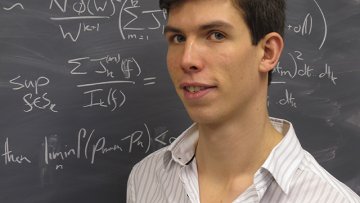Searches for small-scale anisotropies from neutrino point sources with three years of IceCube data
Sarkar, S
Astroparticle Physics
volume 66
39-52
(17 Jan 2015)
Development of a general analysis and unfolding scheme and its application to measure the energy spectrum of atmospheric neutrinos with IceCube
Sarkar, S
European Physical Journal C
volume C75
issue 3
116-116
(11 Mar 2015)
Mon, 27 Oct 2014
14:15
14:15
L5
Closed symmetric differentials on projective surfaces
Fedor Bogomolov
(Courant Institute and Nottingham)
Mon, 20 Oct 2014
14:15 -
16:30
L5
Mirror symmetry for varieties of general type
Mark Gross
(Cambridge)
Abstract
I will discuss joint work with Ludmil Katzarkov and Helge Ruddat. Given a hypersurface X in a toric variety of positive Kodaira dimension, (with a certain number of hypotheses) we construct an object which we believe can be viewed as the mirror of X. In particular, it exhibits the usual interchange of Hodge numbers expected in mirror symmetry. This may seem puzzling at first. For example, a curve of genus g would be expected to have a mirror such that h^{0,0}=g, which is not possible for a variety. However, our mirror is a singular scheme Y along with a perverse sheaf F, whose cohomology carries a mixed Hodge structure. It then makes sense to compute Hodge numbers for F, and we find the traditional exchange of Hodge numbers.
Mon, 13 Oct 2014
14:15 -
15:30
L5
Non-reductive geometric invariant theory and applications in algebraic, symplectic and hyperkahler geometry
Frances Kirwan
(Oxford)
The 2014 SASTRA Ramanujan Prize has been awarded to Dr. James Maynard of Oxford University and the University of Montreal, Canada for his contribution to Number theory, especially in the field of Prime Numbers.
Thu, 04 Dec 2014
14:00 -
15:00
L5
Is the Helmholtz equation really sign-indefinite?
Dr Euan Spence
(University of Bath)
Abstract
The usual variational formulations of the Helmholtz equation are sign-indefinite (i.e. not coercive). In this talk, I will argue that this indefiniteness is not an inherent feature of the Helmholtz equation itself, only of its standard formulations. I will do this by presenting new sign-definite formulations of several Helmholtz boundary value problems.
This is joint work with Andrea Moiola (Reading).



